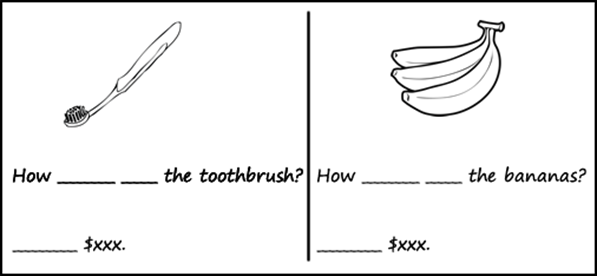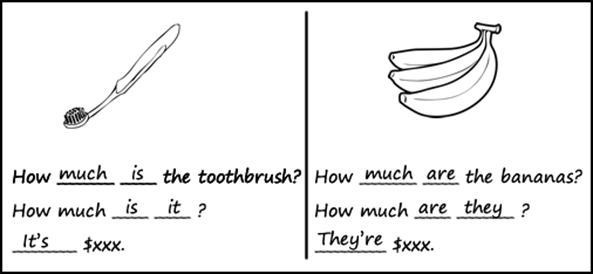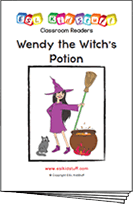Menu
Download the accompanying materials to this lesson plan - sign up here
Resources and materials for ESL Kids teachers
This is a fun, action packed lesson based around the topic of shopping. Students role play going shopping for different objects and asking for prices. Students will need to have a good command of numbers (for prices) to do this lesson.
See our "Warm Up & Wrap Up" page.
1. Play "Guess the price"
Before class, prepare 8 to 10 objects that you know the prices of in the local currency (check in stores or online for current prices). Some ideas: food/drink, electronic products, household goods, clothes, newspapers/magazines, toothbrush, stationery, watches/jewelry, etc. Use objects in different price ranges and make sure some objects are plurals (e.g. shoes, bananas).
In class, lay out the objects along a table so everyone can see all the objects. Start by eliciting the vocab of each object. Then tell the class they are going to play a price guessing game. Put students in pairs or small groups and give each group a piece of paper. Set a time limit of 3 minutes and have the groups discuss and write down their guesses for the prices of each object.
Next, we are going to find out which group guessed the closest for each object – but to do so your students will have to ask you for the prices of the objects … (see next point)
2. Introduce the structure "How much is/are …?”
Draw two of the objects from the table on the board – on the left a singular object and on the right a plural object. Write on the board the following using your local currency symbol):

Elicit the missing words:
How much is the toothbrush?
It’s $xxx.
How much are the bananas?
They’re $xxx.
Now you have the structures in place you can complete the “Guess the price” game. For the first object, have a student use the structure on the board to ask you for the price. Say the price. Find out which group guessed the closest – the group (or groups) that does wins 1 point, however, anyone who guesses the exact price gets 2 points. Do this for each object, each time having a different student ask for the price. At the end, find out which group is the winner with the most points.
3. Practice asking for prices
First, we’ll start with a controlled practice. In the pairs, students take turns asking for the prices of the objects from the “Guess the price” game using the structures on the board. Monitor and check that everyone is using the singular/plural form correctly.
Next, put students into different pairs. Model the activity with another student to show the class what to do, as follows:
Teacher: What’s that? (pointing at the student’s pen)
Student: It’s a pen.
Teacher: How much is it?
Student: It’s about (150 yen).
Notice, we have used a question with the pronoun “it” instead of the object. Write this question on the board. Then elicit the plural form and also write it on the board, as follows:

Students then take turns asking their partner questions about the prices of things on their desks, in their pencil cases, in their bags and pockets, their clothes and accessories and around the classroom. As students are speaking, write any good expressions you hear on the board. Encourage students to use expressions such as:
4. Do the “A/B Shop” pair work worksheet
Students need to work in pairs again for this activity. Give out the worksheets – “A’s Shopping List” to one student in the pair and “B’s Shopping List” to the other. Students then take turns asking how much the items are on the other student’s sheet to complete their shopping lists.
5. Read classroom reader "Wendy the Witch’s Potion"
 This reader really helps to reinforce the new structures with a fun story about a witch’s shopping trip. Before class, download and print out the reader "Wendy the Witch’s Potion". As you go through each page, point to the pictures of the ingredients and get everyone to speculate what they might be, for example:
This reader really helps to reinforce the new structures with a fun story about a witch’s shopping trip. Before class, download and print out the reader "Wendy the Witch’s Potion". As you go through each page, point to the pictures of the ingredients and get everyone to speculate what they might be, for example:
Teacher: (reading from page 3 and 4) "Hello, may I help you?", “Hello, Yes, please”. Look at those (on page 4). What do you think the witch is holding?
Students: Frogs legs?
Teacher: Let’s check. (reading) ... "6 frogs legs, please". You were right! Yuk!
Continue through the story, getting everyone to say what they think the ingredients are from the pictures.
After reading the story, give out a reader worksheet to each student and have pairs or small groups fill in Wendy’s shopping list from memory. Finally, quickly read through the story again to check the answers.
---
Alternatively, watch our video version of the reader (Internet connection required):
6. Introduce some more shopping phrases
The classroom reader introduced some more useful shopping phrases. Let’s see if your students can remember some. Tell the class that you are going to write some phrases from the story on the board. Students should copy them into their notebooks, filling in the missing words as they go (answers in parenthesis):
Students can check their answers with their partners. Then ask individual students to come up to the board and fill in missing blanks.
Point out the difference of a/any in:
Ask if anyone can tell you what the difference is. Then explain, using examples, that we use singular when we only expect there to be one item, and use plural when we expect there to be more then one item (a good example is in a student’s pencil case – it would be more natural to say “Do you have a stapler?” than “any staplers”).
7. Play the “Shopping Board Game”
Students will now practice using the phrases on the board by playing a fun board game. Before class, print out enough copies “Shopping Game” sheets 1 and 2 for each pair. In class, put students in pairs and give each pair a game board (sheet 2). Elicit the object drawings on the game board. Then give out sheet 1 and read the instructions. Pairs will need a dice and each player a counter to move around the board. Players then roll the dice and move around the board, stopping to have shopping conversions until they have bought all of the items on their shopping list.
As everyone is playing, walk around and help with vocabulary and mistakes.
8. Play “Classroom shopping”
We’ll finish with a fun activity that practices all of the lesson’s structures. Students are going to walk around the classroom having shopping conversations with other students and buying objects with money.
You’ll need some toy money for this game (e.g. Monopoly game money) and paper or plastic shopping bags (one per student).
Start by telling everyone they must put three of their personal items on the table at the front of the class. Anything will do – phones, pens, dictionaries, rings, shoe laces, etc. Then take out the shopping bags and randomly put the students’ items into the bags, so that each bag has three different items in them. Make sure students don’t see which bags you put their items in – a good idea is to have everyone cover their eyes when you do this.
Now, give each student a bag and ask them to look inside their bag. If anyone has any of their own personal items in their bag they must bring them back to the table at the front, and then the teacher puts them in different student’s bags. The idea is to make sure each student has a bag with three items in, none of which are their own.
Tell students that they must find their items and buy them back!
Divide out the toy money so that everyone has the same amount (it doesn’t matter how much each student has).
Now model the activity. Indicate that you are looking for your red pen (give to a student and put in his/her shopping bag). First, go to one student who doesn’t have your pen and roleplay (gesturing at the phrases on the board when necessary):
Teacher: Hello.
Student: Hello, may I help you?
Teacher: Yes, please. Do you have any pens?
Student: No, sorry. I don’t.
Teacher: Ok, thank you. Goodbye.
Next, go to the student who does have you pen. Again, roleplay:
Teacher: Hello.
Student: Hello, may I help you?
Teacher: Yes, please. Do you have any pens?
Student: Do you want red or blue?
Teacher: Red, please.
Student: Yes, I do!
Teacher: How much is it?
Student: Umm. It’s $40.
Teacher: $40! That’s expensive! How about $20?
Student: Ok, here you are.
Teacher: Thank you!
Student: You’re welcome.
Take you pen, put it in your bag and hand over the toy money. Explain the objective is to find and buy back your items with the toy money.
Have students mingle around the classroom asking for their items and negotiating to get their items back. This can be a lot of fun as some students are sure to bargain for high prices and some may run out of money!
At then end, find out who has managed to buy all three of their items back and who is the best businessperson by making the most money!
1. Assign Homework: "How much is/are 1" worksheet.
2. Wrap up the lesson with some ideas from our "Warm Up & Wrap Up" page.
 Found a mistake?
Found a mistake?
Please let us know
Full access to all resources on ESL KidStuff including lesson plans, flashcards, worksheets, craft sheets,
song downloads, classroom readers, flashcards app and songs app.